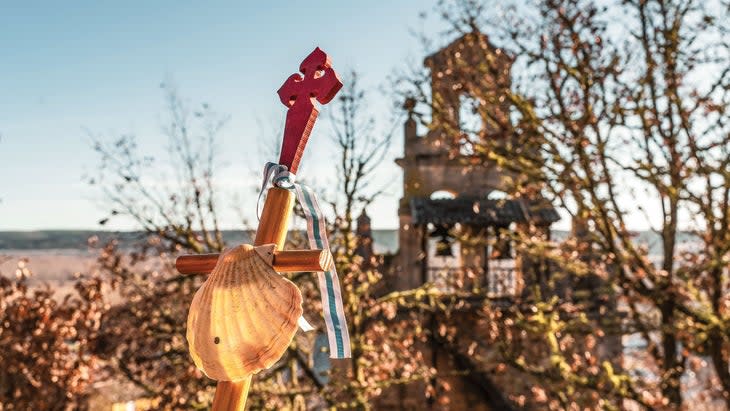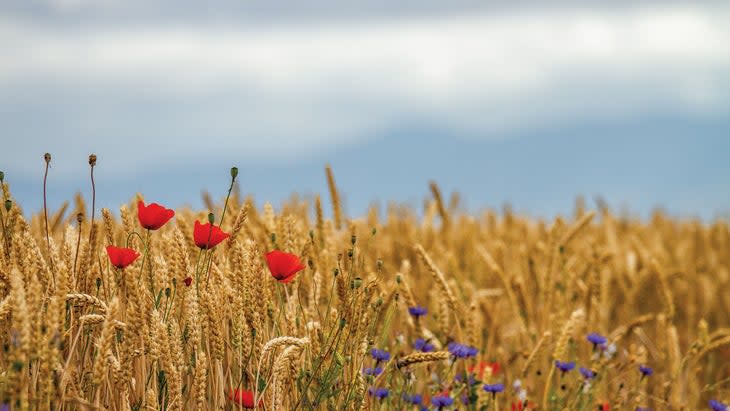Breathe, Hike, Repeat: Finding Deeper Meaning on Spain’s Camino de Santiago
This article originally appeared on Outside
I clawed up the steep mountainside near Leon, Spain, digging my fingernails into clay to steady my body, pitched forward under my pack.
Step, claw. Step, claw. Step. Heavy clouds threatened to downpour. Wind whipped tendrils of hair across my face. My rain jacket whispered softly. Sweat stung my eyes. My quads burned. My lungs gasped. Focus, almost there.
It was July, 2018 and I was 330 miles into the French Way of El Camino de Santiago, a 560-mile blend of mountainous singletrack, pavement, farm road, and vineyard paths across Northern Spain. The Camino is actually a network of routes through Europe leading to Santiago de Compostela in northwestern Spain and originates from a 9th-century Catholic pilgrimage to pray at St. James's bones, allegedly buried in the cathedral there. In a normal year, some 300,000 people make the trek.

I didn't embark on a pilgrimage, as millions do, for religious reasons. I was raised in a liberal Catholic household, and though I had an inherent understanding of the Camino's Christian context, I went for a life reset. As I approached 30, I was tired. Tired of noise and disconnection. Of forgetting what I ate for breakfast; rapid-fire emails; bowing to bosses; scrolling through people's curated lives on social media. So, I quit my job in publishing to hike The Camino solo and contemplate life's two fundamental questions: Who am I and why am I here? I knew, having hiked the final 60-mile stretch from Santiago de Compostela to Finisterre twice before, that it wasn't a vacation. It was a soul-seeking journey. No one else could carry my pack, or walk the miles for me.
Like 186,198 other pilgrims walking the French Way that year, I carried a pilgrim's passport. It became my most sacred possession, wrapped safely in plastic, tucked deep in my pack. A 70-something Frenchman had presented it to me when I registered my hike in Saint-Jean-Pied-de-Port, France. Colorful ink stamps from the Camino's historic sites sprinkled the card-stock--testament to hundreds of miles on foot. To the Santiago Pilgrims Office, it would be proof enough to record my name on a Latin certificate saying I completed the trail. To me, it held memories, and was my ticket to low-budget beds at pilgrim-reserved hostels.

For the entire 33-day trek, I carried only essentials and hiked 20-plus miles per day. Without a map (like most others), I followed yellow arrows and scallop-shell signposts marking the trail through rural villages, humming towns, crimson poppy fields, silver fir thickets, and rows of plump grapes.
Three weeks in, I began to understand why some refer to the Camino as a great metaphor for life. It hurt. At that point, I had hiked enough of the trail to know pain. I'd been soaked by rain, pelted by hail, scorched by sun. Chapped lips, sunburn, sweat stains, voracious hunger, and eternal exhaustion were just side effects. Each step's pinch and bite promised blood between blistered toes. Time and distance under my pack's weight peppered bruises on my hips and collarbones. I became an expert in self-rehab. All pilgrims do. At each day's end, I'd loosen my trail runners, peel wool socks from open sores, knead aching muscles, and fall into a six-hour coma. Then, repeat it the next day. Profanity muttered in foreign accents by my fellow pilgrims reminded me that pain is more universal than language.

But I also found joy, unearthing bliss in simple things: aromatic eucalyptus forests and rose-gold sunrises; a breeze and clouds that floated with me; sinks to rinse sweaty socks; duct tape and a wide-brimmed hat; soft black vineyard dirt; silence and salty French fries; rivers to soak swollen feet; cafe con leche. Most of all, joy came through connections with fellow pilgrims.
As the journey unfolded, my Camino crew formed--an IT manager from Sweden, an obstetrician from New Jersey, a university student from England, an opera singer from Pamplona, and a cancer survivor from Barcelona, among others. Small talk only lasts a mile or two. We hiked together for days, laughing, swearing, crying, sharing. To walk El Camino--or any long path--is to live a shared vulnerability. We cultivated intimate conversation unlike anything I've experienced. We talked not of politics or profession, but of life's joys and sorrows, speaking our truths, fears, darkest secrets, and innermost desires, free from judgement or pretense. In essence, we were walking naked.
On paper, we had little in common. And yet, we each came to the Camino to embrace deep, arduous, soul-changing work vital to self-actualization. Everyone was here to discover something, and in our shared humanity, the trail's magic became clear: Though we were all broken, together we were somehow whole.
On day 21, with rain looming and no promise of sunrise, I pushed over the Montes de Leon to El Acebo, 7.5 miles from Foncebadon--the basecamp village where most pilgrims stop for the night to inhale pasta, slurp beer, and treat blisters.
Step, claw. Step, claw. Step. I stumbled as the ground evened out. Lifting my gaze, I finally saw it. Cruz de Ferro: a 3-foot-tall iron cross, mounted on a tall wooden pole marking El Camino's highest point, a sacred apex for many pilgrims. The cross was planted in a colossal mound of stones, ribbons, letters, weather-beaten pictures, prayer beads, extinguished candles--tokens of pilgrims passed by.
Alone and grateful for a moment of silence, I unclipped my pack and set it down. My pilgrim's scallop shell, tied to the outside, clacked on the ground. I climbed the pile and took six small stones from my pocket, one for each of my family members and me, pulled from the Eagle River in my Colorado backyard. I tore paper from my journal and scribbled prayers to the universe, then wrapped stones in my words, and set them down.
I rested my palm and forehead on the cool wood and inhaled. As I looked up at the cross it began to rain. It took me a moment to notice the taste in my mouth: a cocktail of mist, sunscreen, and salt. My heart felt full. I relished this peace as drizzle washed my cheeks. Then, I climbed carefully down the pile of intentions, hoisted my pack, and wished "Buen Camino" to two breathless pilgrims cresting the hill. I hiked on toward a warm meal, dry clothes, antiseptic spray, and dreamless rest in my cotton sleep sack.
Though historically Christian, the modern spirituality of El Camino doesn't seem to hinge on doctrine or dogma. The path aligns with the Milky Way galaxy (used by medieval pilgrims to navigate the journey), and is considered a "thin place"--where the veil between Earth and cosmos feels translucent. Though I'm not religious per se, I exercise my version of spirituality and The Way honored it.
The trek unfolded for me in three parts. Physically, during the first 179 miles from Saint-Jean-Pied-de-Port to Burgos, I learned to walk. My body hardened, bruises and blisters formed and healed. I slowed down and plugged into the present. Worries concerning my next meal or bed or career move faded. And my urgency to arrive in Santiago evaporated.
The middle section, 102 miles from Burgos to Leon, held the mental battle. For seven days, I crossed flat arid plains under beating sun where water was scarce. I chased a flat, endless horizon. "You better be OK with being in your own head," my brother, a three-time Camino pilgrim, had warned me. Thoughts came and went, and to my delight, I found freedom from past or future concerns. I simply was where I was.
The final stretch, 198 miles from Leon to Santiago, brought spiritual growth. As the miles melted, I found myself grieving the end the hike. I had grown accustomed to walking. To pain, joy, presence. But I also felt gratitude for the wisdom I'd gained on the trail. It taught me that I'm much stronger than I think I am. That life can be simple, if I make it so. That it's important to slow down and smell the flowers; beauty is in people and details. That when I look for it, I can find kindness everywhere. I felt more authentically me than ever before.
I continued for three days and 70-some miles past Santiago to the Atlantic Ocean. It had taken me more than a month of blood and sweat to reach open water. In the final miles along a white-sand beach, I waded, reflecting on the peace I felt at Cruz de Ferro. The journey was the toughest, most fruitful thing I've done. This is the common experience. The Camino is a deeply personal journey for all who attempt it, yet somehow still universal.
Since El Camino, I've learned to keep moving. As with any pilgrimage, there's no training for life. It takes grit, humor, perseverance, and courage to live well, despite fear. Just as I did on The Way, I choose to walk on, even if it hurts, it's uncomfortable, or desperately monotonous. These lessons form the kit of my life.
Its wisdom calls me daily to pick up my pack and march on. To trust, find beauty, and be vulnerable. To share pain, joy, and connection. To, with practice, patience, faith, and grace, continue walking.
This story was originally published in Backpacker Magazine
For exclusive access to all of our fitness, gear, adventure, and travel stories, plus discounts on trips, events, and gear, sign up for Outside+ today.

